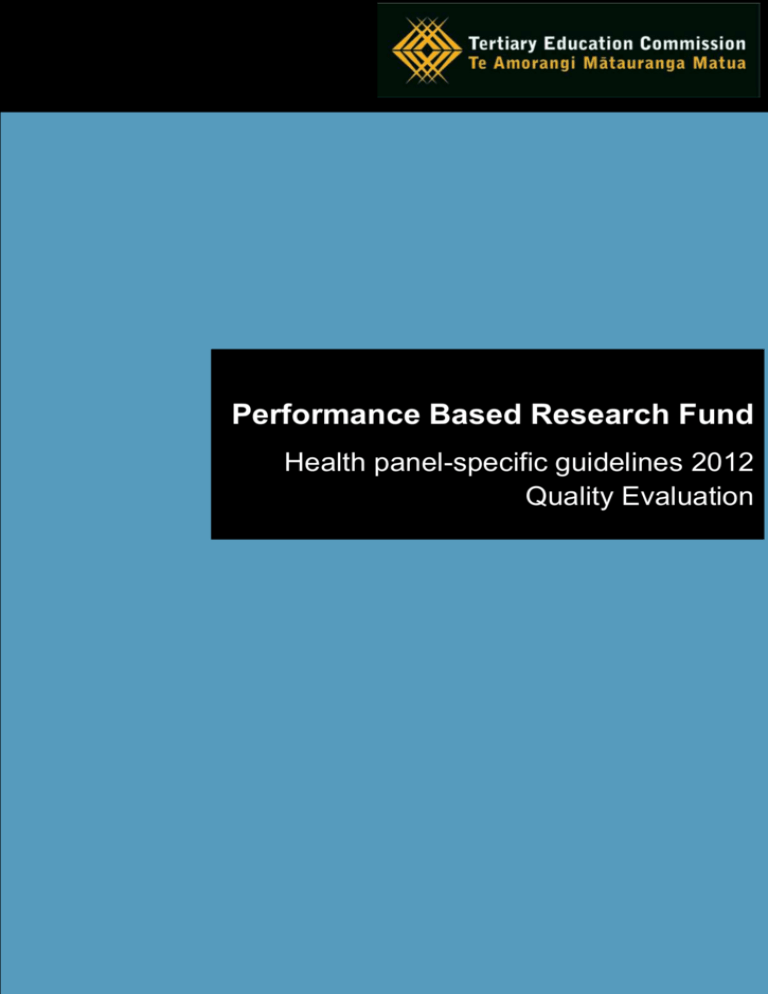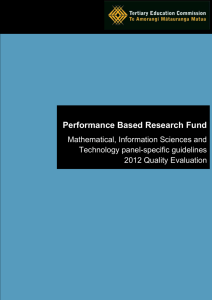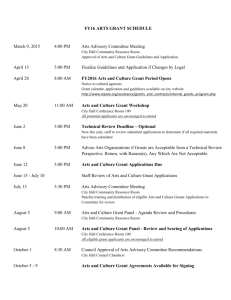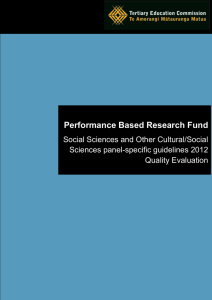Performance Based Research Fund: HEALTH panel
advertisement

Performance Based Research Fund Health panel-specific guidelines 2012 Quality Evaluation Introduction The HEALTH panel-specific guidelines must be read in conjunction with the PBRF Quality Evaluation Guidelines 2012. Panels have developed these guidelines to assist academic staff with the processes of developing and submitting Evidence Portfolios (EPs). These guidelines provide advice on specific areas that relate to the subject area of the panel and do not replace or supersede the requirements for EPs that are set out in the PBRF Quality Evaluation Guidelines 2012. Panels assess EPs without reference to Quality Categories gained by academic staff from their participation in the 2003 and/or 2006 Quality Evaluations. HEALTH panel-specific guidelines Description of panel coverage The HEALTH panel will assess EPs in the subject areas described below. The descriptions should be considered a guide – they are not intended to be exhaustive. Audiology Dentistry Health psychology and mental health Nursing Nutrition and dietetics Occupational therapy Optometry and optical sciences Pharmacy Physiotherapy Speech and language therapy Sport and exercise science Veterinary Other health studies Overlaps are likely to occur with other panels, including Medicine and Public Health, Social Sciences and Other Cultural/Social Sciences; and Maori Knowledge and Development. The membership of peer review panels is designed to enable panels to assess the quality of research in most areas, including those which have a professional or applied outcome. However, it is recognised that a small number of academic staff will have research outputs, that require expert advice from outside the scope of the panel membership and that may need to be considered by the Professional and Applied Research Expert Advisory Group. Further information on this is provided below. Expectations for standard of evidence to be supplied The HEALTH panel expects that research outputs will normally be peer-reviewed journal articles describing research studies. While other output types will be considered on their merits by the panel, a staff member should explain why these have been chosen as Nominated Research Outputs (NROs) instead of peer-reviewed journal articles. Academic staff completing EPs may wish to indicate in some way the relative ranking and impact factor a journal may have. Elaboration of the definition of Research Publication of case reports without a research component would not normally be considered to fit the PBRF definition of research. For the general Guidelines, see Chapter 1 Section D: What Counts as Research? Types of research output The general Guidelines apply. Additional advice from expert advisory groups Academic staff may request that their EP be considered by the Pacific Research and/or the Professional and Applied Research Expert Advisory Groups. In these cases, the EP will be referred to the Expert Advisory Group which will determine whether it meets the criteria for them to consider it. Those EPs that do meet the criteria will be assessed by the Expert Advisory Group and this assessment will be provided to the peer review panel. The final decision on a Quality Category remains with the peer review panel. The criteria that will determine whether or not the Pacific Research and the Professional and Applied Research Expert Advisory Groups will accept EPs for review, will be published on the TEC website. Professional and Applied Research A small number of academic staff will have research outputs of a professional or applied nature that differ significantly in their impact from those usually considered as part of the Quality Evaluation process. The impact of research outputs put forward to the Professional and Applied Research Expert Advisory Group must be supported by documented evidence and must have occurred within the six year period set out for research outputs. Impacts that are yet to occur, or are projected will not be considered. Examples of research-based outputs, which could be referred to the Professional and Applied Research Expert Advisory Group, may include innovations in diagnostic tests and/or therapeutics. The Expert Advisory Group will expect a high level of verifiable evidence of indicators of excellence within the EP. The evidence must support the referral to the Expert Advisory Group and demonstrate that the research output and its impact are significantly different from those usually considered by peer review panels. Pacific Research The Expert Advisory Group will provide specific advice on what can be considered Pacific research. This will provide academic staff with information to determine if their research outputs demonstrate the characteristics of Pacific research, and whether their EPs should be considered by the Expert Advisory Group. Indications of the minimum quantity of research output expected to be produced during the assessment period The general Guidelines apply, see Chapter 2 Section C: Guidelines for Completing the Research Output Component and Chapter 3 Section C: Assessing and Scoring the Three Components of an EP. Special circumstances The general Guidelines apply, see Chapter 2 Section F: Dealing with Special Circumstances. Definitions of Quality Categories The general Guidelines apply, see the topic: What do the Quality Categories Mean? in Chapter 3 Section A: Panel Assessment: Introduction, and the final three topics of Chapter 3 Section D: Assessing and Scoring the Three Components of an EP – starting with Scoring an EP: Allocating Points for Research Outputs. Treatment of non-standard, nonquality-assured and jointly produced research outputs The HEALTH Panel is aware that it is usual for original research papers to have more than one author; and that different research groups have varying understandings about authorship and order of authorship. Where there are multiple authors, academic staff must ensure that their contribution to the research output is clearly defined in the “My Contribution” section. Academic staff should not use percentages, but describe their role in conceptualisation of the project, research design, data collection, data analysis, interpretation of results and write up. An assurance of co-authors’ agreement should be included. Proportions of Nominated Research Outputs (NROs) to be examined1 The HEALTH Panel expects to review 50% of all NROs submitted. Use of specialist advisers The general Guidelines apply, see the topic: Using a Specialist Adviser in Chapter 3 Section B: Allocating EPs to Panel Members and Obtaining Additional Input. Elaboration of the descriptor and tie-points for the Research Output (RO) component The general Guidelines apply, see topics: Scoring the RO component and Scoring an EP: Allocating points for research outputs in Chapter 3 Section C: Assessing and Scoring the Three Components of an EP. Elaboration of the descriptor and tie-points for the Peer Esteem (PE) component The general Guidelines apply, see topic: Scoring an EP: Allocating points for peer esteem in Chapter 3 Section C: Assessing and Scoring the Three Components of an EP. Elaboration of the descriptor and tie-points for the Contribution to the Research Environment (CRE) component The general Guidelines apply, see topic: Scoring an EP: Allocating points for contribution to the research environment in Chapter 3 Section C: Assessing and Scoring the Three Components of an EP. Other relevant information required for panel assessors to accurately assign Quality Categories to EPs No panel specific guidance. 1 “Examined” is defined as either reading an NRO in full, substantially or sufficiently to make an informed assessment, or (for NROs which by their nature cannot be read) an equivalent level of scrutiny.









